|
Nearly six hundred corpses lay in rows at twenty morgues in Chicago on the evening of December 30, 1903.
They were the victims of a fire at the city's newest luxury playhouse, the
Iroquois. It remains today as America's
worst theater disaster. The process of identification
had started at the scene and would last for the
next five days. Relatives streamed through poorly-lit rooms
looking for loved ones amidst bodies of mostly
women and children, blue from trampling, blackened from smoke,
some easily recognized, others charred and
dismembered. Of the searchers, some wore
fine garments and traveled from morgue to morgue
in costly automobiles and hired carriages.
Many more arrived on foot, still wearing singed and soot-covered clothing and
bandages. For them the endless rows of
bodies were a continuation of the nightmare
that'd begun hours earlier at the Iroquois.
They'd escaped the fire but the terrifying scenes in the
theater and grief over lost spouses, children,
parents or siblings would tear at them for years.
For a few, in an era long before recognition of PTSD, it would
lead to suicide and madness.
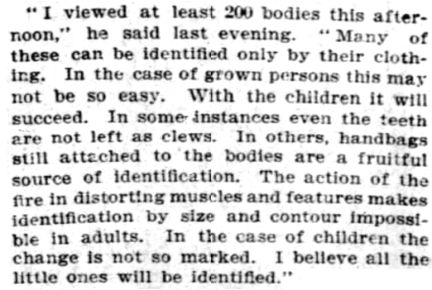
Dr. Joseph Springer, coroner's physician
Chicago Tribune Dec 31, 1904, pg 4▼1
Following a procedure devised by the coroner's
office, police attached a numeric code to each
body and recorded gender and approximate age.
Such possessions as jewelry, purses, pocket
contents and watches were placed in
correspondently numbered envelopes that were
sent to the police department and kept in a
vault. When a victim was identified, the
family was required to produce evidence of their
relationship to the victim before being allowed
to remove the body or take possession of
personal effects.
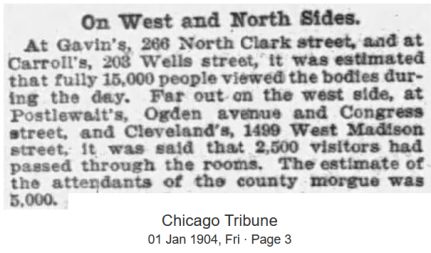
When a body was badly injured, the contents in its matching envelope
were sometimes critical to verifying an identification.
A shopkeeper's label in a shoe, a receipt in a
pocket, or an engraved watch given as a
Christmas gift five days earlier, all became
part of DVI▼2 in the Iroquois disaster.
Inquest forms were completed for claimed bodies,
and burial permits issued, so that bodies could
be taken home immediately or kept for embalming
and funeral preparation. Identified
victims awaiting transport for burial were
covered with a sheet and searchers were
repeatedly reminded to refrain from removing the
sheets. Thousands streamed through the
morgues, some in search of loved ones, some
indulging curiosity. There were many
victim funerals for the next week but the ground in Chicago was frozen too solid for
immediate interment and after the funerals hundreds of bodies were
stored in crypts until the ground thawed in the
spring.
Hundreds of victims were recognized and taken home that
night in carriages, or transferred to train
stations for shipment. That allowed more space in
morgues for the remaining bodies to be separated
enough for searchers to walk between them and
better see faces and clothing details.
Around midnight police closed the morgues to the
public, to rearrange bodies and compile lists of
the known dead, injured and suspected
missing.
The lists were supplied to Chicago
newspapers and the next day the world learned
about America's worst theater disaster.
For some relatives, the search
went on at home, too, by studying newspaper lists for
clews.▼3 Did Maria have a red velvet skirt?
A blue flannel petticoat? Pearl seed
brooch?
|
|
People in some cities learned of the
Iroquois fire that same night, just hours after
the last body was removed from the theater.
In Chicago, while officials shifted bodies and clerks
transmitted victim lists to newspapers, word of the
fire spread throughout the city by
telephone
party lines.▼4 On the west coast, and in
a couple midwest cities, the fire announcement was read beneath gas lights after dinner in
late-edition newspapers. At least
thirty-five cities — two dozen on the west
coast, nine in the Midwest and one in NYC ran
the story on December 30, including seven
special editions.
Though victim names
had not yet been published, messages began to
flow into Chicago's telegraph office. Families in distant
cities sent telegrams after poring over letters from
relatives who had written of
plans to attend Mr. Bluebeard. "Did
Edna go to Mr.. Bluebeard? Wednesday?
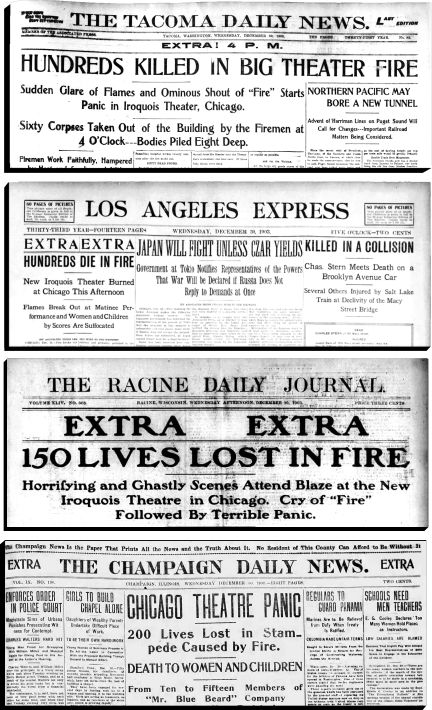
A majority of identifications were made within
two days, by January 1, 1904
|
Days after fire |

|
Remaining unidentified |
|
1 |
Fewer than 100 |
|
2 |
224 |
|
3 |
21 |
|
4 |
12 (consolidated at County Morgue) |
|
5 |
6 |
|

|
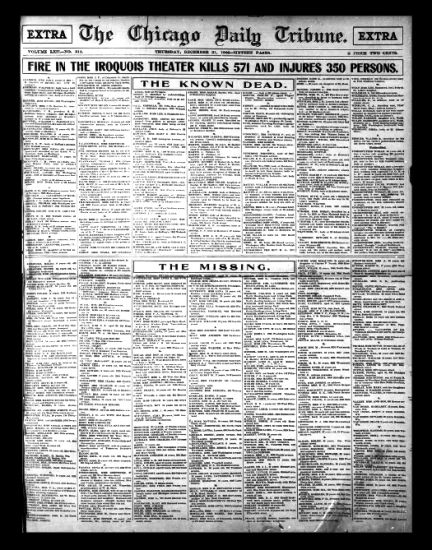
Sobering descriptions of unidentified victims were
published in newspapers
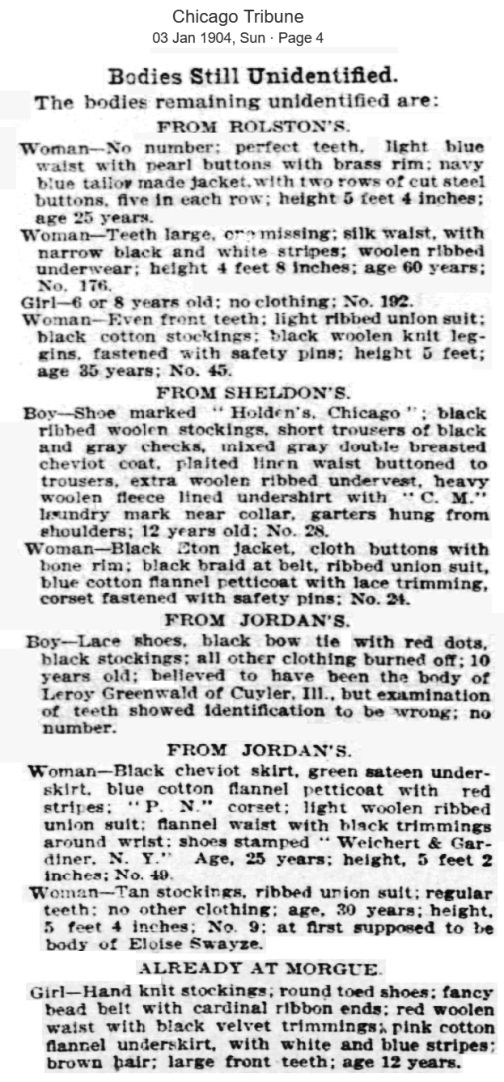
|
|
Discrepancies and addendum
1.
Dr. Joseph E. Springer (1867–1936)
testified at the coroner's inquest by coroner's deputy
Lawrence Buckley. After graduating
from the University of Illinois College of
Physicians and Surgeons he joined the
coroner's office staff in 1898 and remained
until retirement in 1929, becoming a
respected criminologist. One of his
five daughters became a U.S. Marshal.
2. Disaster Victim Identification is
the process of identifying the remains of
people who have died in a mass fatality
incident. Techniques include
fingerprinting, use of dental records and
DNA profiling. In 1903 Chicago, only
dental records were cited, in around
twenty cases. Though finger printing
was being used elsewhere around the world,
including in New York City, Captain Michael
P. Evans of the Chicago Bureau of
Identification had nine months before the
Iroquois disaster pronounced it as
inadequate, based on its use by Pinkerton
Detective Agency, seemingly in a single
instance. Pinkerton had submitted
finger prints in a criminal investigation
but jurors rejected the evidence.
Fingerprinting would have helped in three to
four Iroquois identifications.
3. Clews was an archaic spelling of clue.
4. Long-distance telephone service made it to
Chicago in 1892 but nationally, few of the two million residential household phone
installations had long-distance capacity.
Single-instance long-distance service could
be purchased but cost as much as a week's
pay for the average worker, and depended
upon a recipient answering the phone that
had the willingness and capacity to pursue
an answer that even Chicago residents
couldn't obtain at that early point.
Telegrams were cheaper and faster.
|
